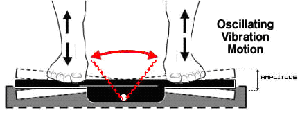October 3, 2011
Shake It Up, Baby: A Look At Whole Body Vibration

By Michael D. Shaw
Followers of the Olympic Games are well aware of the means—legitimate and otherwise—used by Soviet Bloc countries to gain an edge on the competition. Especially notable was the incredible performance by the East Germans, whereby a country with fewer than 17 million people doubled its Olympic output from 20 to 40 gold medals in just four years (1972 to 1976).
It is now known that drugs fueled this success, with as many as 800 former team members claiming serious after effects. In one particularly lurid case, shot-putter Heidi Krieger became Andreas Krieger in 1997, blaming the effects of massive ingestion of male hormones during her career.
Fortunately, though, non-drug enhancement technologies were also developed. One of these is Whole Body Vibration (WBV).
The history of WBV usually begins with references to its use in the Russian space program. It had been observed that cosmonauts (as well as our astronauts) tended to lose bone density and muscular strength during their mostly zero-gravity space missions. Russian scientist and former gymnast Vladimir Nazarov adopted the idea of vibrational training, using it to strengthen Russian cosmonauts during space flights.
Vibration therapy was first introduced in the 1860s by Swedish physician Gustav Zander, who pioneered many mechanical exercise devices. His Zander Institutes were an early version of today’s health clubs. In 1895, Dr. John Harvey Kellogg—health enthusiast and deathly competitor of his more famous brother Will Keith Kellogg of Kellogg’s Corn Flakes fame—invented a whole body vibration machine, initially configured as a chair. A standing version was brought out later.
Returning to Nazarov, he discovered that not only did WBV stop the loss of bone density, it actually increased bone density, and strengthened muscle tissue, as well. Soon after, WBV was employed as a training aid for elite athletes. He spoke of a substantial increase in flexibility and strength after the application of vibrations in the athletes he studied.
In 1999, Dutch Olympic trainer Guus van der Meer would bring this technology to the health and fitness industry. Within a short time, testimonials for his machine started to appear, from celebrities, rehabilitation centers, and famous athletes. Typically, the machines offer a selection of vibration frequencies—as high as 60 Hz.
Various claims are proffered for this therapy, some of which are backed up by a limited amount of clinical data. WBV is said to:
- Develop explosive power
- Improve muscle strength and tone
- Increase blood flow
- Increase oxygenation in the blood
- Raise testosterone level, promoting fast-twitch white muscle fibers to fully recover at a quicker rate
- Raise growth hormone level essential to repairing and regenerating tissue
- Lower cortisol level, thus minimizing the effects of stress
- Improve postural reflexes
- Increase flexibility
- Increase range of motion
- Improve balance and coordination
- Improve mobility, owing to the natural locomotor cross-over pattern of vibration
My first experience with whole body vibration took place a few weeks ago at the office of chiropractors Phil Golinsky and Michelle Severson, in Herndon, VA. Dr. Golinsky is a big proponent of continuing your exercise program, as you are under treatment…
I encourage the patients to keep exercising. Sometimes, they will tell me that their other doctors warned them to stop exercising, but I don’t care. I say to them, “You’re here now because your condition did not improve. Go work out. If you hurt yourself, I’ll fix it. Your body will tell you if you’re doing too much.”
People start to feel better when they exercise. Endorphins are produced, and this leads to faster healing.
Golinsky is a natural bodybuilder, and believes that WBV has improved his strength, and has jump-started his workouts. His office is one of the few chiropractic centers to have WBV equipment, and his patients really seem to like it. Only a few minutes are needed to experience WBV.
Unlike some in his profession, Golinsky does not offer chiropractic as a cure for all ills. Indeed, as a psoriasis sufferer, after trying every conceivable natural remedy, he found that the drug Humira was the only thing that worked for him.
As to WBV, while there are many proponents, there are also doubters, including popular strength and conditioning coach Sal Marinello and Mayo Clinic physical medicine and rehabilitation specialist Edward R. Laskowski, M.D. Absent better data, I would encourage those interested in WBV to use a machine, and simply determine how well it works for them.

